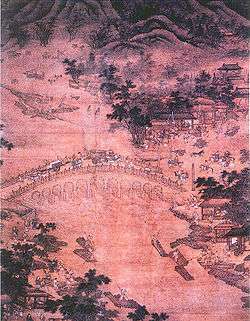Marco Polo Bridge
| Lugou Bridge 卢沟桥 | |
|---|---|
 | |
| Coordinates | 39° 50′ 57″ N, 116° 12′ 47″ E |
| Locale | Fengtai District, Beijing |
| Other name(s) | Marco Polo Bridge |
| Characteristics | |
| Total length | 266.5 m |
| Width | 9.3 m |
| Number of spans | 11 |
| Piers in water | 10 |
| History | |
| Construction end | 1698 |
| Marco Polo Bridge | |||||||||
| Traditional Chinese | 盧溝橋 | ||||||||
|---|---|---|---|---|---|---|---|---|---|
| Simplified Chinese | 卢沟桥 | ||||||||
| Literal meaning | Lu Ditch Bridge | ||||||||
| |||||||||
The Marco Polo Bridge or Lugou Bridge[1] is a stone bridge located 15 km southwest of Beijing city center in the Fengtai District. It bridges the Yongding River, a major tributary of Hai River. Situated at the eastern end of the bridge is the Wanping Fortress, a historic 17th-century fortress, with the Museum of the War of Chinese People's Resistance Against Japanese Aggression inside.
In recent years, the water of Yongding River has been diverted to different areas of Beijing so often there is no water under the bridge.
Names
The name "Marco Polo Bridge" derives from its appearance in his book of travels, where he praised it highly. The names "Lugou" or "Lukou Bridge" and "Lugouqiao" or "Lukouchiao" derive from Lugou, a former name of the Yongding.[2]
History
Over this river there is a very fine stone bridge, so fine indeed, that it has very few equals in the world.

Construction of the original bridge on this site commenced in 1189, the final year of Emperor Shizong of Jin's reign and was completed under his successor in 1192. Following damage from the flooding Yongding, the bridge was reconstructed under the Kangxi Emperor of the Qing dynasty in 1698. The Marco Polo Bridge is well-known because it was highly praised by the Venetian traveler Marco Polo during his visit to China in the 13th century (leading the bridge to become known in Europe simply as the Marco Polo Bridge), and for the 20th century Marco Polo Bridge Incident, which marked the beginning of the Second Sino-Japanese War (1937–1945).
Following the Communist takeover of China in 1949, the bridge was decked in asphalt and carried motor vehicular traffic. The nearby New Marco Polo Bridge (Chinese: 盧溝新橋; pinyin: Lúgōu Xīnqiáo) was completed in 1971 and traffic was eventually moved to it and, later, the Jingshi Expressway during a 1980s restoration of the bridge.
Structure
The Marco Polo Bridge is 266.5 meters (874 ft) in length and 9.3 m (30.5 ft) in width, supported on 10 piers and 11 segmental arches.[note 1] Hundreds of artistically unique stone lions from different eras line both sides of the bridge. The most intriguing feature of these beasts is the fact that there are more lions hiding on the head, back or under the belly or on paws of each of the big lions. Investigations to determine the total number of animals have been carried out on several occasions but the results have proved inconsistent, ranging anywhere from 482 to 501. However, record has it that there were originally a total of 627 lions. The posture of each lion varies, as do their ages. Most date from the Ming (1368–1644) and Qing (1644–1911) dynasties, some are from the earlier Yuan dynasty (1271–1368); while the few lions dating from as long ago as the Jin dynasty (1115-1234) are now quite rare.
Four ornamental columns each 4.65 m (15 ft) high and a white marble stele stand at the ends of the bridge. One stele, installed on top of a stone tortoise, records the reconstruction of the bridge by the Kangxi Emperor of the Qing dynasty in 1698. The other stele bears calligraphy by the Qianlong Emperor, a grandson of the Kangxi Emperor. It reads "Morning moon over Lugou" (盧溝曉月 Lúgōu xiǎoyuè). For the 800 years since its completion, the bridge has been a well known scenic spot in Beijing.
As well as being famed for its aesthetic features, Marco Polo Bridge is also considered to be an architectural masterpiece. It is built of granite, with a large central arch flanked by ten smaller ones. Each of the ten piers is protected by triangular iron pillars that have been installed to prevent damage by flood and ice.
See also
Notes
- ↑ The number of "legs", or piers, is correct here, even though with X arches one would expect X+1 piers. The "discrepancy" is that each end, or abutment, does not count as a pier. Were they to be counted, one would have the proper number of piers (12) for the 11 arches mentioned.
References
- ↑ Damian Harper and Daniel McCrohan. Lonely Planet China. Lonely Planet, 2007. ISBN 978-1740599153. p. 176.
- ↑ "Beijing: Its Characteristics of Historical Development and Transformation", Symposium on Chinese Historical Geography, p. 8.
External links
| Wikimedia Commons has media related to: |
- Marco Polo Bridge at Structurae
- Marco Polo Bridge at China.org.cn
- Marco Polo Bridge at Travel China
Coordinates: 39°50′57″N 116°12′47″E / 39.84917°N 116.21306°E